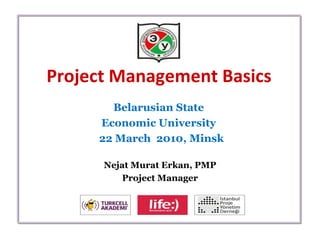
Project Mng Basics Belarusian State University Final
- 1. Project Management Basics Belarusian State Economic University 22 March 2010, Minsk Nejat Murat Erkan, PMP Project Manager
- 4. “ A project is a temporary endeavor undertaken to create a unique product, service, or result. ” (PMBOK) What Is Project?
- 8. A Successful Project Quality Time Cost Scope
- 13. Failure Reasons in Projects
- 23. Project Life Cycle Process Groups INITIATING PLANNING EXECUTING MONITORING & CONTROLLING CLOSING Define a new project or phase by obtaining authorization. Establish scope, refine objectives and develop course of action to attain those objectives. Complete the work defined in the project management plan to satisfy the specifications. Track, review and regulate the progress to meet the performance objectives defined in the project management plan. Finalize all activities to formally complete all project / phase / contractual obligations.
- 25. Definition of a Program SCOPE QLTY TIME COST CONTR. /PROC. COMM. HR RISK A group of related projects managed in a coordinated way to obtain benefits and control not available from managing them individually. Programs may include elements of related work outside the scope of the discrete projects in the program. Project PROGRAM Related work Project Sub-Program Project Project
- 26. Definition of a Portfolio The projects and programs of the portfolio may not necessarily be interdependent or directly related; they compete for monetary and other corporate resources. Program PORTFOLIO A collection of projects, programs and other related work that are grouped together to facilitate effective management of the work to meet strategic business objectives. Other related work Project Program Project Project
- 29. Project and Product Life Cycles SCOPE QLTY TIME COST CONTR. /PROC. COMM. HR RISK Corporate or Business Life Cycle Policy Identify Project Realization Product Dispose Planning Needs Conception In Service Product Life Cycle Feasibility Acquisition Operations Dispose Concept Develop Implement Closeout Project Life Cycle
- 34. Project Management Roles SCOPE QLTY TIME COST CONTR. /PROC. COMM. HR RISK Project Sponsor Project Manager Project Leader Project Leader Project Leader
- 36. Fuctional Organization General Manager Fuctional Manager Fuctional Manager Fuctional Manager Project Manager Team Member Team Member Team Member Team Member Team Member Team Member Team Member Team Member Team Member Team Member Team Member Team Member
- 37. Matrix Organization (Weak) General Manager Functional Manager Functional Manager Functional Manager Team Member Team Member Team Member Project Manager Team Member Team Member Team Member Team Member Team Member Team Member Team Member Team Member Project Team
- 38. Matrix Organization (Strong) General Manager Manager of Project Manager Functional Manager Functional Manager Project Manager Project Manager Project Manager Project Manager Team Member Team Member Team Member Team Member Team Member Team Member Team Member Team Member Project Team
- 43. Project Life Cycle Process Groups
- 44. Level of Activity in Project Life Cycle
- 47. The Project Planning Process SCOPE QLTY TIME COST CONTR. /PROC. COMM. HR RISK Ref: PMBOK 4 th Ed., Figure 3-8, page 47
- 53. Work Breakdown Structure Project Main Tasks Sub-Tasks Activities 001 100 200 300 110 120 111 112 113 310 320 321 322
- 54. Project Organisation WBS Leve 1 WBS Level 2 Project Manager Feasibilty Management Prototype Management Manufacturing Management Project Management Planning Management Advetisement Planning Communic. Planning Training Planning Stocking Planning
- 57. Gantt View in MS Project
- 60. Defining the Crtical Path Exercise: Which is CP? And how many days? A B C D E F 3 7 2 3 4 3 0 G 2 2
- 65. Benefits of Alignment to Business Outcomes SCOPE QLTY TIME COST CONTR. /PROC. COMM. HR RISK Planning Definition Execution Start Up Ability to influence the outcomes Closure Cost of Mitigation Steps High Low Early risk management and mitigation builds better valued projects Full None
- 66. ISO 3 1 000 & Project Risk Management Process QLTY TIME PMBOK vs. ISO 31000 risk process – differences lie in the framework & context
- 69. Performance Measurement Baseline QLTY TIME 1. Define the work scope 2. Schedule the work 3. Allocate budgets to schedule 100 40 60 80 BUDGET AT COMPLETION PERFORMANCE MEASUREMENT BASELINE TIME $ PROGRAM BUDGET MANAGEMENT RESERVE
- 75. Quality Planning Quality Control Point Quality Control Point Quality Control Point => Phase Deliverables => Final Deliverables Analysis Phase Developing Phase Executing Phase Closing Phase => Phase Deliverables => Phase Deliverables
- 78. Procurement / Contracting
- 81. Спасибо = Teşekkür The Maiden’s Tower
- 82. N. Murat Erkan Project Manager Turkcell & Life:) [email_address] +90 532 210 2437 Turkey 25 909 00025 Belarus Contact Details
Notas do Editor
- -Teori x: yakın takip, teori y serbet bırakma -Maslow: 1 psikolojik, 2 güvenlik, 3 sosyal, 4 özsaygı, 5 nirvana -Herzberg (artan): 1 başarma, 2 tanınma, 3 işin kendisi, 4 sorumluluk, 5 ilerleme -Sorun çözme (azalan): geri çekilme (en kötü), zorlama, yumuşatma, ödün verme, problem çözme (en iyi) -Güç tipleri: mevkii, cezalandırıcı, ödüllendirici, uzman, torpil/tanıdık
- Ölçülebilir Olması Açık Olarak Tanımlanabilen Başlangıç/Bitiş Tarihleri nin Olması Bir Çıktıya Sahip Olma sı Kolaylıkla Tahmin Edilebilen Zaman/Maliyet Kırılımında Olması Kabul E dilebilir Limitler İçindeki Tamamlanma Süresi nin Planlanması Projede Kesinti Olmaksızın Tamamlanabilme si
